11 Best WordPress Page Builders: A Comprehensive Review
WordPress page builders are an essential tool for website developers and content creators looking to build professional-grade websites without the need for complex coding skills.
These drag-and-drop tools allow users to easily create and customize the layout, design, and functionality of their website pages, making it quick and easy to build a website that meets their specific needs and goals.
In this guide, we’ll take a look at the top WordPress page builders currently on the market, and outline the benefits of using these tools to create and manage your website.
We’ll also discuss the pros and cons of each page builder, and provide a guide on how to get started with each one.
What Is The Best WordPress Page Builder?
Here are my top picks of the best WordPress page builders.
1. Elementor
Elementor is arguably one of the best WordPress page builders in town. It offers customization options and pre-designed templates for creating professional-grade websites.

It is a robust and user-friendly page builder that empowers both beginners and experienced designers to create stunning websites without any coding knowledge. It offers a drag-and-drop interface, making it easy to customize layouts, sections, and elements.
Pros
- Intuitive Interface: Elementor’s drag-and-drop interface ensures a smooth and effortless design process.
- Wide Range of Widgets: It comes with a rich library of widgets for various functionalities.
- Template Library: Offers a diverse collection of pre-designed templates for quick setup.
- Responsive Editing: Design and preview your site for different devices seamlessly.
- Theme Builder: Allows you to design headers, footers, and other theme elements.
Cons
- Learning Curve: While user-friendly, mastering advanced features might take some time.
- Loading Times: Excessive use of complex elements can lead to slower loading times.
How to Get Started
Getting started with Elementor is a breeze:
- Install and activate the Elementor plugin.
- Create a new page or post.
- Click on the “Edit with Elementor” button.
- Drag and drop elements onto the canvas and customize them.
- Preview and publish your design.
2. Beaver Builder
Beaver Builder is another well-to-do WordPress page builder that is simple, has an intuitive interface for creating and customizing website pages, and works well with beginners too.
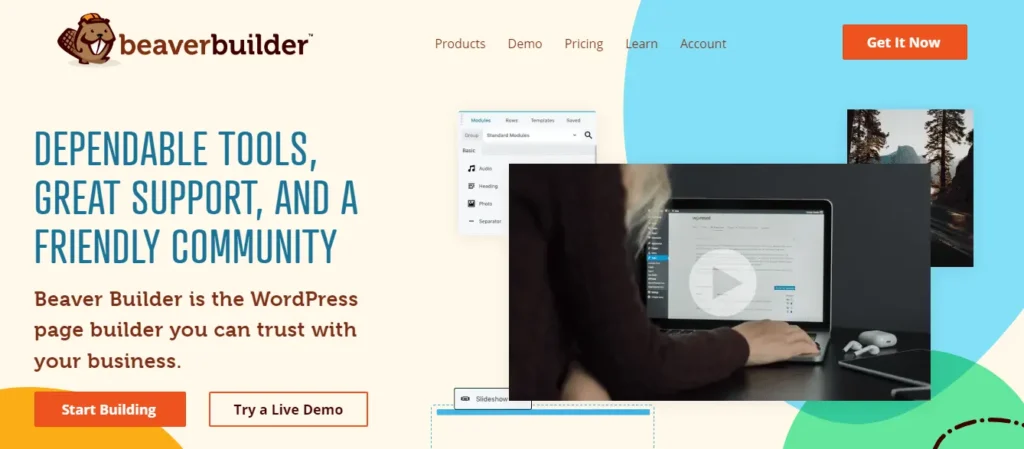
Beaver Builder as a flexible WordPress page builder, emphasizes simplicity and versatility. Its modular approach allows you to build complex layouts without compromising on performance.
Pros
- Frontend Editing: Make changes and see results in real-time on the front end.
- Reusable Templates: Save and reuse templates across multiple pages.
- Developer-Friendly: Offers hooks and filters for developers to extend functionality.
- Lightweight Output: Generates clean code for faster loading times.
Cons
- Limited Free Version: The free version lacks some advanced features present in the premium version.
- Design Limitations: Advanced customization might require some CSS knowledge.
How to Get Started
Start using Beaver Builder:
- Install and activate the Beaver Builder plugin.
- Create a new page or post.
- Click on the “Page Builder” tab.
- Drag modules to the canvas and customize them.
- Save and publish your design.
3. Divi
Divi Builder, just like others on this list, allows customization options and comes with beautiful pre-designed templates for creating professional-grade websites.

With elegant design options and a user-friendly interface, Divi is an all-in-one WordPress page builder solution for creating visually appealing websites.
Pros
- Visual Editing: Real-time front-end editing for a seamless design experience.
- Divi Theme Integration: Seamlessly integrates with the Divi theme for comprehensive control.
- Global Elements: Create global sections and elements to maintain consistency.
- Advanced Effects: Apply animations and effects to enhance user engagement.
Cons
- Learning Curve: Divi’s extensive features might require some time to master.
- Shortcode Dependency: Some elements generate shortcodes, potentially causing compatibility issues when switching themes.
How to Get Started
Begin using Divi:
- Install and activate the Divi Builder plugin.
- Create a new page or post.
- Click on the “Enable Divi Builder” button.
- Choose a pre-designed layout or start from scratch.
- Customize your content and style.
- Save and publish your design.
4. Visual Composer
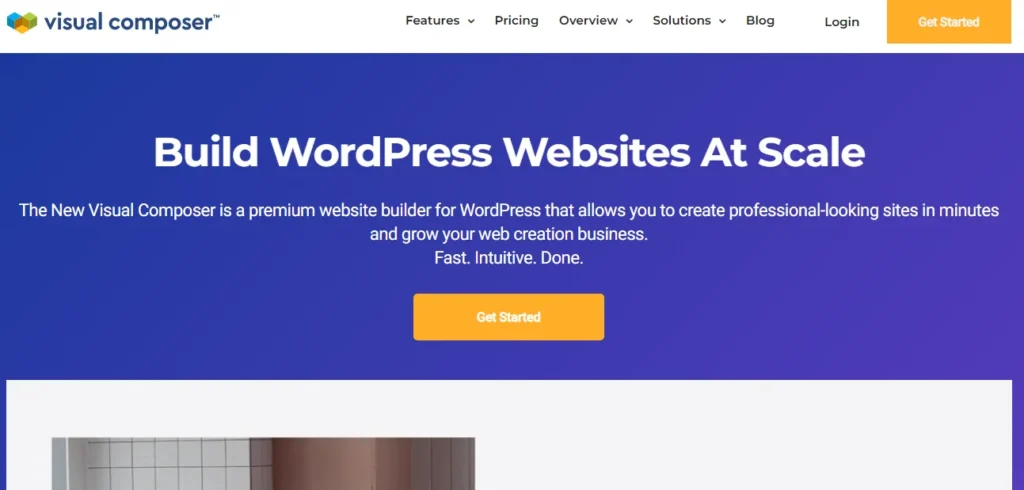
Visual Composer comes with a drag-and-drop interface and live preview, customizable ready-made templates,
Beginners to professionals alike have been using Visual Composer in creating cutting-edge WordPress websites.
Visual Composer is a feature-rich WordPress page builder that offers a comprehensive set of tools for creating dynamic and interactive websites. It provides both front-end and back-end editing options.
Pros
- WYSIWYG Editing: Edit your content on the front end and see the results in real-time.
- Advanced Design Options: Offers a wide range of design elements and customization options.
- Extensions and Add-ons: Expand functionality with various extensions and third-party add-ons.
- Grid Layouts: Easily create complex grid-based layouts for your pages.
Cons
- Learning Curve: Due to its extensive features, new users might require time to grasp all functionalities.
- Code Cleanup: The generated code might require some manual cleanup for optimization.
How to Get Started
To begin with Visual Composer:
- Install and activate the Visual Composer plugin.
- Create a new page or post.
- Click on the “Edit with Visual Composer” button.
- Choose a template or start building from scratch.
- Drag and drop elements onto the canvas and customize them.
- Save and publish your design.
5. Thrive Architect
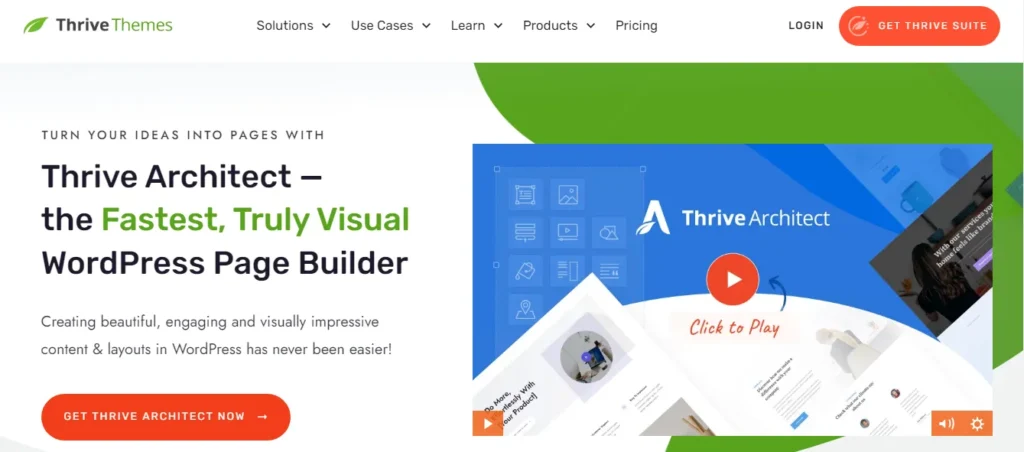
Next on the list is Thrive Architect, and it is not just a powerful WordPress page builder that offers several customization capabilities and pre-made themes. No!
Thrive Architect is a conversion-focused WordPress page builder designed to create engaging and high-converting content. It’s particularly suited for marketers and business owners.
Pros
- Conversion Elements: Offers specialized elements for creating sales pages and landing pages.
- Pre-designed Templates: Includes professionally designed templates for various purposes.
- Content Blocks: Provides pre-built content blocks to streamline page creation.
- A/B Testing: Integrated A/B testing for optimizing conversion rates.
Cons
- Focused on Marketing: While great for marketing purposes, might be less suitable for general website design.
- Lacks Some Design Elements: The range of design elements might be more limited compared to other builders.
How to Get Started
Getting started with Thrive Architect:
- Install and activate the Thrive Architect plugin.
- Create a new page or post.
- Click on the “Edit with Thrive Architect” button.
- Choose a template or build from scratch.
- Customize elements, add content blocks, and configure settings.
- Save and publish your design.
6. SiteOrigin Page Builder

SiteOrigin Page Builder is pegged on simplicity and ease of use. It’s a great choice for those who prefer a straightforward design process on a free and intuitive WordPress page builder.
Pros
- Row and Widget Layouts: Create responsive layouts using rows and widgets.
- History Revisions: Easily revert to previous versions of your designs.
- Works with Any Theme: Compatible with most WordPress themes.
- Custom CSS: Option to add custom CSS for advanced styling.
Cons
- Basic Design Elements: Might lack some advanced design elements present in other builders.
- Limited Animation Options: Offers fewer animation options compared to more feature-rich builders.
How to Get Started
To start using SiteOrigin Page Builder:
- Install and activate the SiteOrigin Page Builder plugin.
- Create a new page or post.
- Click on the “Page Builder” tab.
- Add rows and widgets to your layout.
- Customize content and styles.
- Save and publish your design.
7. Brizy

Brizy is a relatively new WordPress page builder (as of the time of updating this post) that prides itself on its user-friendly interface and modern design options.
And it has not just got a cool name but it aims to simplify the design process for both beginners and professionals.
Pros
- Drag-and-Drop Editing: Easily drag elements onto your canvas for quick design.
- Intuitive UI: User-friendly interface with a minimal learning curve.
- Global Styling: Create consistent styles across different sections.
- Dynamic Content: Incorporate dynamic content from WordPress into your design.
Cons
- Limited Widgets: Offers fewer widgets compared to more established builders.
- Advanced Features: Might lack some advanced features found in older builders.
How to Get Started
To begin with Brizy:
- Install and activate the Brizy plugin.
- Create a new page or post.
- Click on the “Brizy” tab.
- Drag elements from the left panel onto your canvas.
- Customize content, style, and layout.
- Save and publish your design.
8. WPBakery
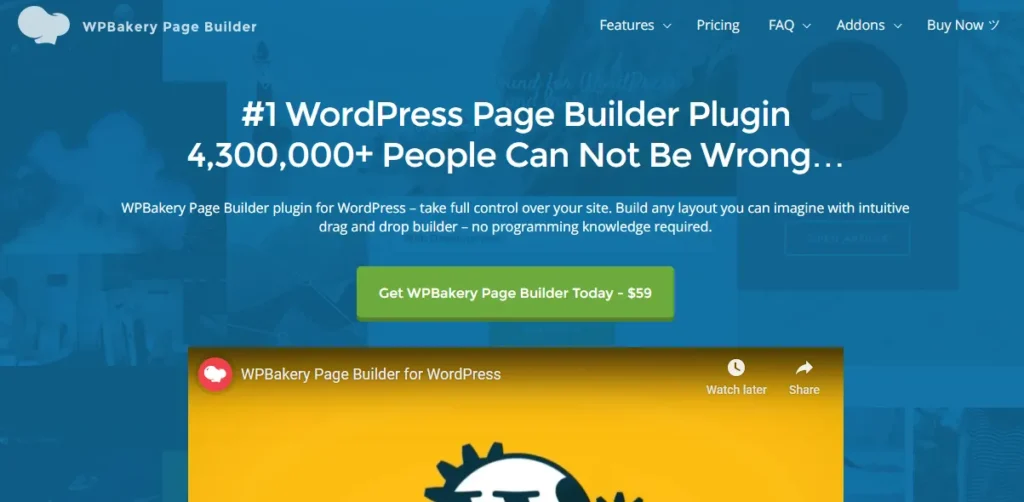
WPBakery, formerly known as Visual Composer, is a widely used WordPress page builder that offers an extensive range of features and flexibility. It’s particularly known for its compatibility with many themes and plugins.
Pros
- Backend and Frontend Editing: Edit on either the backend or frontend for convenience.
- Huge Element Library: Offers a vast collection of elements and templates.
- Third-Party Compatibility: Works well with various themes and plugins.
- Role Manager: Control user access to different elements of the builder.
Cons
- Complex Interface: The abundance of options might be overwhelming for some users.
- Shortcodes in Content: Uses shortcodes for content, which can be problematic when switching themes.
How to Get Started
To get started with WPBakery:
- Install and activate the WPBakery plugin.
- Create a new page or post.
- Click on the “Backend Editor” or “Frontend Editor” button.
- Add elements to your layout and customize them.
- Save and publish your design.
9. SeedProd
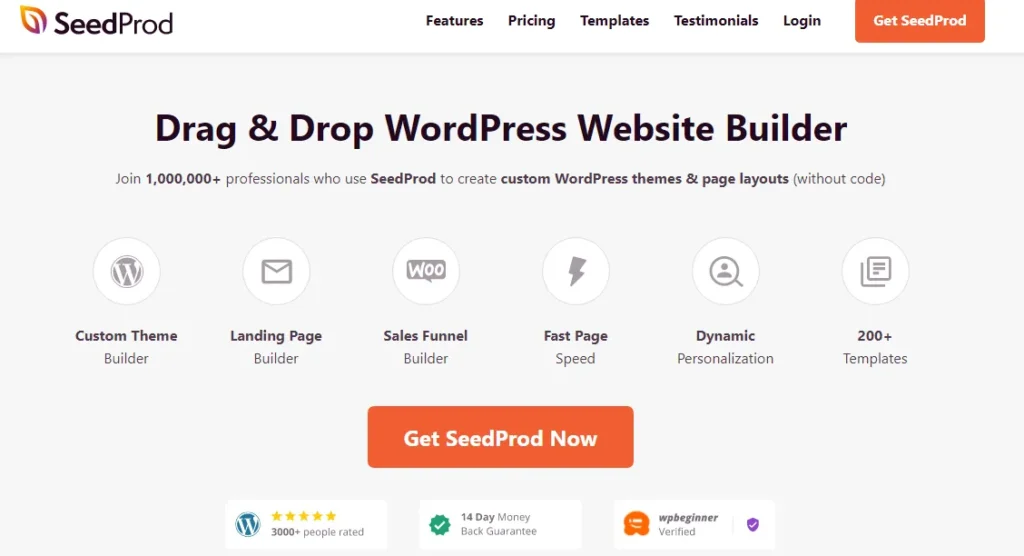
SeedProd specializes in creating coming soon and maintenance mode pages. It’s a valuable tool for building anticipation and collecting leads before your website launch.
Though it’s job description is tiny, it does not make it any less a WordPress page builder than the others on this guide.
Pros
- Coming Soon Pages: Easily create eye-catching coming soon and maintenance mode pages.
- Pre-built Templates: Offers pre-designed templates for quick setup.
- Lead Capture: Integrate with email marketing services to capture leads.
- Social Sharing: Include social media sharing buttons on your page.
Cons
- Niche Use Case: Primarily designed for coming soon and maintenance pages, limited in other areas.
- Features Might Be Overkill: If you only need a basic coming soon page, some features might be unnecessary.
How to Get Started
To start using SeedProd:
- Install and activate the SeedProd plugin.
- Access the SeedProd settings from the WordPress dashboard.
- Customize your coming soon or maintenance mode page.
- Integrate with your email marketing service.
- Save your settings and activate your page.
10. Oxygen
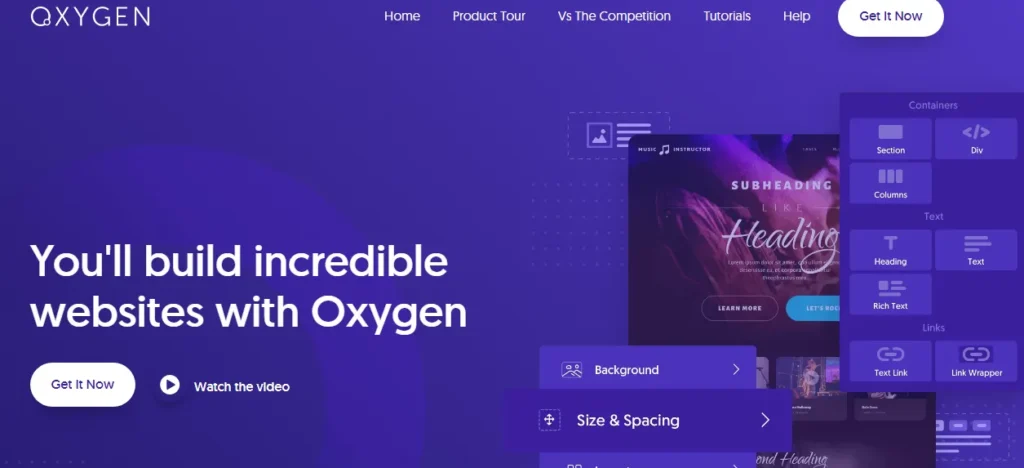
With the Oxygen page builder plugin, you can get complete control over design and functionality of your website, down to the smallest details.
This powerful WordPress page builder is geared towards developers and designers who want to create intricate and custom websites.
Pros
- Visual Design: Design visually while retaining full code control.
- Dynamic Data: Integrate dynamic data and custom PHP functionality.
- Global Styles: Create consistent styles across your site with global settings.
- Developer-Friendly: Ideal for those who prefer working directly with code.
Cons
- Learning Curve: Due to its advanced features, it might take time to grasp for non-developers.
- Steep Pricing: Oxygen’s pricing might be higher compared to other builders.
How to Get Started
To start using Oxygen:
- Purchase and download the Oxygen plugin.
- Install and activate the plugin on your WordPress site.
- Start a new Oxygen design.
- Build your layout using drag-and-drop and/or custom code.
- Customize styles and functionality.
- Save and publish your design.
11. Live Composer
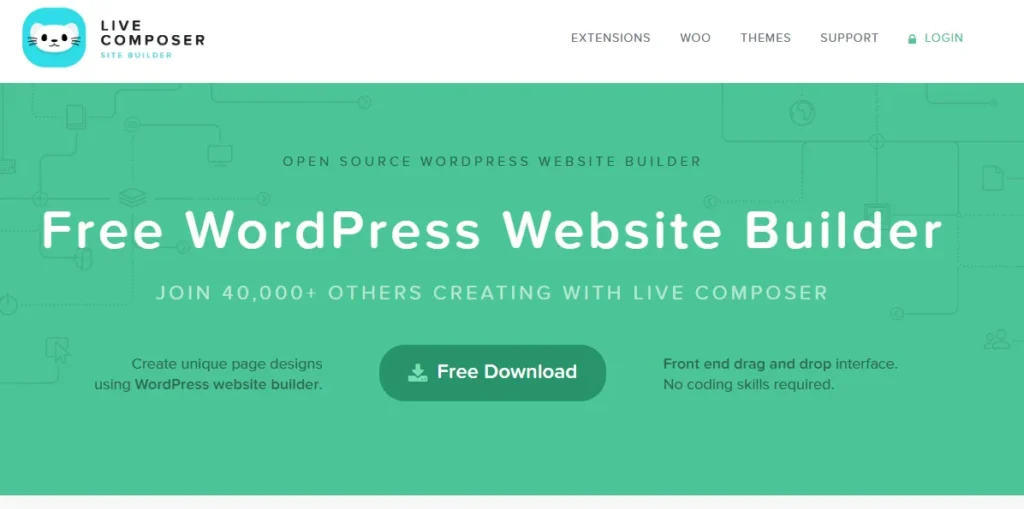
Live Composer is a frontend WordPress page builder that stands so tall for one thing and one thing alone; simplicity and real-time editing. It’s suitable for users who want to see immediate results as they design.
Pros
- Real-Time Editing: Make changes and see results instantly on the frontend.
- Customizable Elements: Tailor the included elements to your needs.
- Inline Text Editing: Edit text directly on the page for convenience.
- Beginner-Friendly: Designed with ease of use in mind.
Cons
- Limited Advanced Features: Might lack some of the advanced features found in more comprehensive builders.
- Styling Options: While intuitive, the range of styling options might be limited.
How to Get Started
To begin with Live Composer:
- Install and activate the Live Composer plugin.
- Create a new page or post.
- Click on the “Enable Live Composer” button.
- Add and customize elements directly on the frontend.
- Save and publish your design.
Benefits of Using WordPress Page Builders
There are several benefits of using a WordPress page builder for your website:
User-friendly
WordPress page builders are designed to be easy to use, even for those with no coding experience.
With a simple drag-and-drop interface, users can easily add, delete, or rearrange elements on their website pages, and preview changes in real-time.
Customization options
WordPress page builders offer a wide range of customization options, allowing users to create a unique, professional-grade website that matches their brand and style.
From pre-designed templates and themes to custom widgets and plugins, users can easily customize every aspect of their website.
Responsive design
WordPress page builders ensure that your website is fully responsive and mobile-friendly, meaning it will look and function seamlessly on all devices.
This is essential for providing a good user experience and boosting your search engine rankings.
Time-saving
Building a website from scratch can be a time-consuming process, especially for those without coding skills.
WordPress page builders allow users to quickly create and customize their websites, saving time and effort in the development process.
Frequently Asked Questions About WordPress Page Builders
A WordPress page builder is a tool that allows users to easily create and customize the layout, design, and functionality of their website pages. These tools typically offer a drag-and-drop interface and a range of customization options, making it easy for users to build professional-grade websites without the need for coding skills.
The best WordPress page builder for your website will depend on your specific needs and goals. Consider the features and customization options offered by each page builder, as well as the price and user reviews. It may also be helpful to try out a few different page builders to see which one works best for you.
Yes, you can switch between WordPress page builders by deactivating the current page builder plugin and activating a new one.
No, you do not need to know how to code to use a WordPress page builder. These tools are designed to be user-friendly and allow users to easily create and customize their website pages with a simple drag-and-drop interface. However, some advanced customization options may require a basic understanding of HTML or CSS.
Yes, most WordPress page builders are designed to ensure that your website is fully responsive and mobile-friendly. This means that your website will look and function seamlessly on all devices, including smartphones, tablets, and desktop computers.
Conclusion
WordPress page builders are an essential tool for anyone looking to create and manage a professional-grade website.
These drag-and-drop tools offer a wide range of customization options and pre-designed templates, making it quick and easy to build a website that meets your specific needs and goals.
In this guide, we’ve outlined the top WordPress page builders currently on the market, including SiteOrigin Page Builder, Brizy, WPBakery, SeedProd, Oxygen, and Live Composer, and provided a guide on how to get started with each one.




